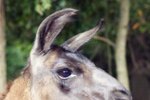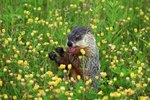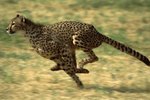
Kinkajous are nocturnal mammals that reside throughout the Americas. They're widespread everywhere from Bolivia to southern locations in Mexico. "Honey bear" is a common nickname for these tree-dwelling creatures. The moniker is a tribute to their penchant for going into beehives. As part of the family Procyonidae, kinkajous are kin to raccoons.
Hello to Honey Bears
Kinkajous are inhabitants of tropical rain forests. They are common within the Amazon basin. They thrive in extremely dense woodlands that don't receive a lot of light -- a result of tree crowns blocking it from above. Adult kinkajous typically achieve lengths of between 16 and 22 inches. They usually weigh between 4 and 7 pounds. They have brownish-gray coats, short limbs, tiny heads and somewhat elongated physiques. Although kinkajous are frequently thought to resemble monkeys, they're not primates.
Tree Life
The kinkajou lifestyle is all about trees. It's not at all common for them to descend from the tree limbs that make their homes. They rest in the daytime, generally in openings of trees. When twilight rolls around, kinkajous get up from their slumber and begin their searches for sustenance. Since kinkajous are equipped with prehensile tails that can handily seize things, they can usually navigate trees with ease. Their tails help them maintain their clutches on trees when they're grabbing meals, for one. They also assist in maintaining equilibrium.
Kinkajous and Feeding
Kinkajous are omnivorous animals that dine on a combination of flesh and plant matter. Fruit is a preference for kinkajous, specifically figs. They typically eat any fruit that's plentiful in their surroundings, however. They also sometimes consume flowers, foliage, eggs, nectar and tiny insects. Kinkajous possess several adaptations that assist them in feeding. Their narrow tongues help them suck honey out from hives, for one. Their sturdy claws aid them in grabbing fruit. Their tails allow them to eat while their bodies are dangling upside down. Kinkajous, for the most part, are independent animals, although they occasionally spend time together, whether for playing or resting. When they look for food, they're generally alone.
Breeding Habits
Female kinkajous typically carry their offspring for anywhere between 98 and 120 days. They bear one or two babies at a time, often in holes in trees. Newborn kinkajous usually weigh around 6 ounces. The mothers wean their babies once they're roughly 2 months old, getting them accustomed to diets of exclusively "real" foods. Young kinkajous usually can take care of themselves once they get to 4 months in age. Male kinkajous do not assist the mothers in raising the youngsters.
References
- University of Michigan Animal Diversity Web: Potos Flavus
- The IUCN Red List of Threatened Species: Potos Flavus
- Smith College Clark Science Center: Mammalian Species - Potus Flavus
- San Diego Zoo Animals: Kinkajou
- National Geographic: Kinkajou
- Animal Planet: Kinkajou
- Oregon Zoo: Kinkajou
- Canadian Organization for Tropical Education and Rainforest Conservation: Kinkajou
Photo Credits
-
Tom Brakefield/Stockbyte/Getty Images




